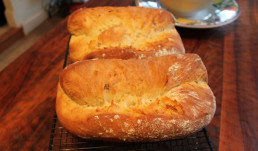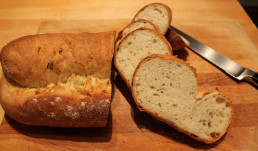The bread has almost a sourdough texture and flavor. It is seriously good. Light, great crumb and chewy crust. A perfect bread.
adapted from Leslie Mackie in Baking with Julia
Makes 2 loaves
- 1 1/2 pounds russet potatoes (about 3)
- 4 teaspoons salt
- 1/2 cup tepid reserved potato water (80 to 90 degrees F)
- 1 tablespoon active dry yeast
- 2 tablespoons extra-virgin olive oil
- 4 3/4 cups unbleached all-purpose flour
Cooking the Potatoes.
Scrub the potatoes and cut them into quarters, peel and all. Toss them into a 2 quart pot, cover with water, add 2 teaspoons of the salt, and boil until the potatoes are soft enough to be pierced easily with the point of a knife. Dip a measuring cup into the pot and draw off 1/2 cup of the potato water; reserve. Drain the potatoes in a colander and then spread them out, either in the colander, or on a cooling rack over a jelly-roll pan, and let them cool and air-dry for 20 to 30 minutes. It’s important that the potatoes be dry before they’re mashed.
Mixing the dough.
When the potatoes are cool, stir the yeast into the reserved potato water (if the water is no longer warm, heat it for a few seconds in a microwave oven–it should feel warm to the touch) and allow it to rest for 5 minutes; it will turn creamy.
Meanwhile, turn the cooked potatoes into the bowl of a mixer fitted with the paddle attachment and mash them. With the mixer on low speed, add the dissolved yeast and the olive oil and mix until the liquids are incorporated into the potatoes.
Replace the paddle with the dough hook and, still mixing on low speed, add the flour and the remaining 2 teaspoons of salt. Mix on low speed for 2 to 3 minutes, then increase the speed to medium and mix for 11 minutes more. The dough will be firm at first and soft at the finish. At the start, it will look dry, so dry you’ll think you’re making a pie crust. But as the dough is worked, it will be transformed. It may even look like a brioche, cleaning the sides of the bowl but pooling at the bottom. Have faith and keep beating.
First rise.
Cover the mixing bowl with plastic wrap and allow the dough to rise at room temperature for 20 to 30 minutes, at which point the dough will have risen noticeably, although it may not have doubled.
While the bread is proofing, position a rack in the bottom of the oven and fit it with a baking stone or quarry tiles, leaving a border of at least 1 inch all around. Preheat the oven to 375 degrees F. Place a linen towel on a baking sheet, rub the towel with flour, and set aside; this will be the resting place for the bread’s final rise. Rub a baker’s peel or baking sheet with cornmeal or flour. Fill a spray bottle with water; set aside.
Shaping the dough.
Turn the bread out into a lightly floured surface and, using a dough scraper, cut the dough in half. To shape each half into a torpedo shape, first shape it into a ball and then flatten it into a disk. Starting at the end farthest from you, roll up the dough toward you. When you’re on your last roll, stop and pull the free end of the dough toward you, stretching it gently, and dust its edge with flour. Finish the roll and, if necessary, rock the loaf back and forth a little to taper the ends and form a torpedo, or football.
Second rise.
Place the loaves on the floured towel, seam side down, and cover them with the ends of a towel (or another towel). Let the breads rise at room temperature for 20 minutes.
Baking the bread.
When you’re ready to bake, spray the oven walls with water and immediately close the oven door to trap the steam. Turn the breads out, seam side up, onto the peel or baking sheet and transfer them to the oven. Spray the oven with water again and bake the loaves for 45 to 50 minutes, or until the crust is very brown, the loaves sound hollow when thumped on the bottom, and, the most important test, the interior temperature measures 200 degrees F when an instant-read thermometer is plunged into the center of the loaves. Remove the loaves from the oven and cool on a rack at least 20 minutes before slicing. While you should wait for the bread to firm up in the cooling process, slather this bread with butter while it’s still warm is a great treat.
- 2-Day Rise Pizza Dough
- A Wholesome Loaf
- Aleppo Tomato Bread
- Bacon and Tomato Swirl
- Bagels
- Barmbrack
- Basic White Bread
- Braided French-Style Bread
- Breadsticks
- Brioche Dough
- Buttermilk Bulgur Bread
- Cheddar Beer Bread Rolls
- Ciabatta
- Cinnamon-Raisin Swirl Bread
- Crusty French Rolls
- Crusty Italian Bread
- Crusty Italian Sourdough
- Danish Pastries
- Double Wheat Whole Wheat Bread
- Five Grain Bread with Walnuts
- Focaccia
- Focaccia
- Focaccia Genovese
- Focaccia Ragusata
- Grandmother’s Dinner Rolls
- Guinness Rye Bread
- Hamburger Buns
- Hamburger Buns
- Hamburger Buns
- Honey Corn Rolls
- Hot Cross Buns
- Irish Country Bread
- Italian Easter Bread (Pinza)
- James Beard Basic White Bread
- James Beard Single Rise Loaf
- James Beard’s French-Style Bread
- Japanese-Style White Bread
- Kanelsnurror
- Knotted Dinner Rolls
- Kolaches
- Medieval Bread
- Milk Bread
- Molasses Oatmeal Bread
- Multi Grain Sandwich Bread
- Multi-Grain Seeded Bread
- No Knead Artisan Bread
- No-Knead Walnut Raisin Bread
- No-Knead White Bread
- Oma’s Christmas Stollen
- Onion Poppy Seed Bread
- Pain Francais
- Pan Rustico – Rustic Spanish Bread
- Pane al Pistacchio
- Pane all’Olio
- Pane Bianco
- Pane di Como Antico
- Pane Pugliese
- Pane Siciliano
- Panettone
- Panini con erbe aromatiche
- Pecorino Cheese Bread
- Pepper Bread
- Pepper Bread
- Pistachio Onion Bread
- Pistachio, Onion, and Cheese Bread
- Pita
- Pogaca Rolls
- Pumpkin Rolls
- Russian Black Bread
- Rustic Bread
- Rustic Potato Bread
- Rustic Red Fife Bread Flour
- Rye Berry Rye Bread
- Rye Bread
- San Francisco-Style Sourdough
- Semelle
- Soft Pretzels
- Sourdough Country Bread
- Tartine’s Sourdough Bread
- Tomato Bread
- Walnut Raisin Bread
- Walnut Raisin Sourdough Bread
- Whole Wheat Buttermilk Bread
- Wisconsin Spicy Cheese Bread



